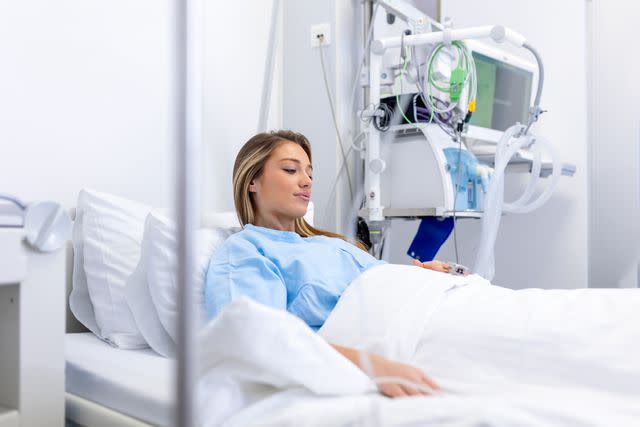Endometriosis Recurrence After Surgery

stefanamer / Getty Images
Medically reviewed by Chioma Ndubisi, MD
Surgery can be used to treat endometriosis, but for some people, the relief is not permanent. Endometriosis can return after surgery.
This article will discuss surgical options for endometriosis, what endometriosis recurrence means, why endometriosis can return after surgery, signs and risk factors of endometriosis recurrence, and how to prevent the recurrence of endometriosis after surgery.

stefanamer / Getty Images
Types of Surgery for Endometriosis
There are several surgical options for treating endometriosis, including:
Laparoscopy
Laparotomy
Hysterectomy
Oophorectomy
Laparoscopy
With a laparoscopy for endometriosis, small incisions are made in the abdomen through which a thin tube with a light, camera, and other small tools are inserted. Endometriosis tissue can be removed (excision) or destroyed using intense heat (ablation).
Laparoscopy can also be used to confirm a diagnosis of endometriosis. Sometimes, both a diagnosis and excision or ablation occur during the same laparoscopic procedure.
Laparotomy
Excision and ablation can also be performed using a laparotomy. During a laparotomy, a larger abdominal incision is made. This surgery is less common than laparoscopy for treating endometriosis.
Hysterectomy/Oophorectomy
A hysterectomy is the surgical removal of the uterus. Sometimes other organs are removed as well, including one or both ovaries, the cervix, and/or the fallopian tubes.
Removal of one or both ovaries is called an oophorectomy. This procedure may be done independently or by removing the uterus and/or other reproductive organs. Removal of both ovaries induces menopause.
Typically, hysterectomy and/or oophorectomy are only used if other treatments have been ineffective.
What Does Endometriosis Recurrence Mean?
There isn't a set definition for the recurrence of endometriosis, but it's generally accepted to refer to one or more of the following:
Relapse of pain
Lack of improvement in infertility
Endometriosis lesions seen via ultrasound or surgery
Why Does Endometriosis Return After Surgery?
Endometriosis may persist after surgery if some endometriosis tissue is left behind, or it can recur, stemming from de novo (new) cells.
After surgery, new endometriosis lesions can develop similarly to the initial endometriosis. The exact cause of endometriosis isn't known conclusively, but one widely accepted theory for menstruating is retrograde menstruation. When this occurs, menstrual blood and tissue flow backward through the fallopian tube and implant on the surface of the ovary or other structures in the pelvis.
A hysterectomy/oophorectomy stops menstruation, but endometriosis recurrence can still occur due to factors such as:
Hormones
Ovarian remnants
Disease persistence
De novo disease
Signs of Endometriosis Returning
Recurrence of endometriosis may not cause noticeable symptoms. In those who do experience symptoms, new or increasing pain with menstruation and/or pelvic pain is commonly noted in studies on endometriosis recurrence after surgery.
Symptoms of endometriosis may include:
Pain with menstruation, such as excruciating menstrual cramps
Chronic low-back and pelvis pain
Problems with fertility
Pain during or after sex
Pain with urination or bowel movements (rarely, blood in stool or urine can occur)
Intestinal/lower abdominal pain
Digestive problems, such as diarrhea, bloating, constipation, or nausea
Heavy periods
Spotting/bleeding between periods
Fatigue/lack of energy
How Quickly Can Endometriosis Grow Back After Surgery?
The time frame for recurrence of endometriosis after surgery is not well-established. Some studies give an overall recurrence rate, while others look at a specific time, but most information on recurrence isn't kept past five years after surgery.
A 2020 study found that the median time to first recurrence of endometriosis after surgery was 31 months, but all participants in this study had recurrent endometriosis lesions confirmed through a second surgery. This data may not apply to those whose recurrence is not significant enough to need further surgery.
Risk Factors for Endometriosis Recurring
There is conflicting evidence for what factors increase the risk of endometriosis recurring after surgery. Studies have found potential risk factors may include:
Pain with menstruation before surgery
Bilateral (affecting both sides) involvement of endometriosis lesions
Previous surgery
Tender nodules in the cul-de-sac (pouch between the rectum and vagina)
Younger age at surgery (possibly due to higher levels of the hormone estrogen)
Higher severity of disease before surgery
Completeness of lesion removal during surgery (tissue left behind can regrow with time)
Larger cyst(s) at surgery
Not all studies agree on these risk factors. It's important to talk to your healthcare provider about the benefits and risks of surgery for endometriosis and your risk of recurrence.
How to Prevent Endometriosis Recurrence
The measures taken to prevent recurrence of endometriosis depend on several factors, including intentions of becoming pregnant.
Some studies have found that pregnancy after surgery may help prevent recurrence of endometriosis. If you wish to become pregnant after surgery, talk to your healthcare provider about your options, how to prepare, and other considerations.
For those not wanting to conceive after surgery, hormonal suppression has been shown by some studies to help reduce the risk of endometriosis recurrence. According to one study, hormonal suppression started within six weeks of surgery for endometriosis surgery can significantly reduce endometriosis recurrence and pain up to one year after surgery.
Some medications that may be used to help reduce the risk of recurrence include:
Hormonal contraceptives, such as oral medications, vaginal rings, or patches
Gonadotropin-releasing hormone (GnRH) receptor agonists
Progestin-only medications
Testosterone derivatives
Aromatase inhibitors
These medications may need to be used long term and can have risks and side-effects. Your healthcare provider can help you determine the best course of treatment for you and your needs.
When to See a Healthcare Provider
It's important to follow all of your healthcare provider's post-operative guidance and to schedule regular follow-up appointments to look for signs of endometriosis recurrence.
You should also see your healthcare provider if you notice symptoms of endometriosis, such as pain or infertility, persist or return after surgery.
Summary
Surgery such as laparoscopy, laparotomy, or hysterectomy/oophorectomy can be an effective treatment for endometriosis. In some cases, endometriosis can recur after surgery.
Endometriosis recurrence generally refers to a return of pain, persistence of fertility problems, and/or observable endometriosis lesions after surgery.
Endometriosis recurrence may result from endometriosis tissue left behind after surgery, the development of new endometriosis tissue through retrograde menstruation, hormonal factors, or ovarian remnants.
There is conflicting evidence on risk factors for endometriosis recurrence after surgery, but some risk factors may include pain with menstruation and/or severity of disease before surgery, younger age at surgery, previous surgery, lack of completeness of tissue removal, and larger cyst(s) at surgery.
Pregnancy after surgery and using medications such as hormonal contraceptives may help reduce the risk of endometriosis recurrence after surgery.
Talk to your healthcare provider about post-operative care and treatment.
